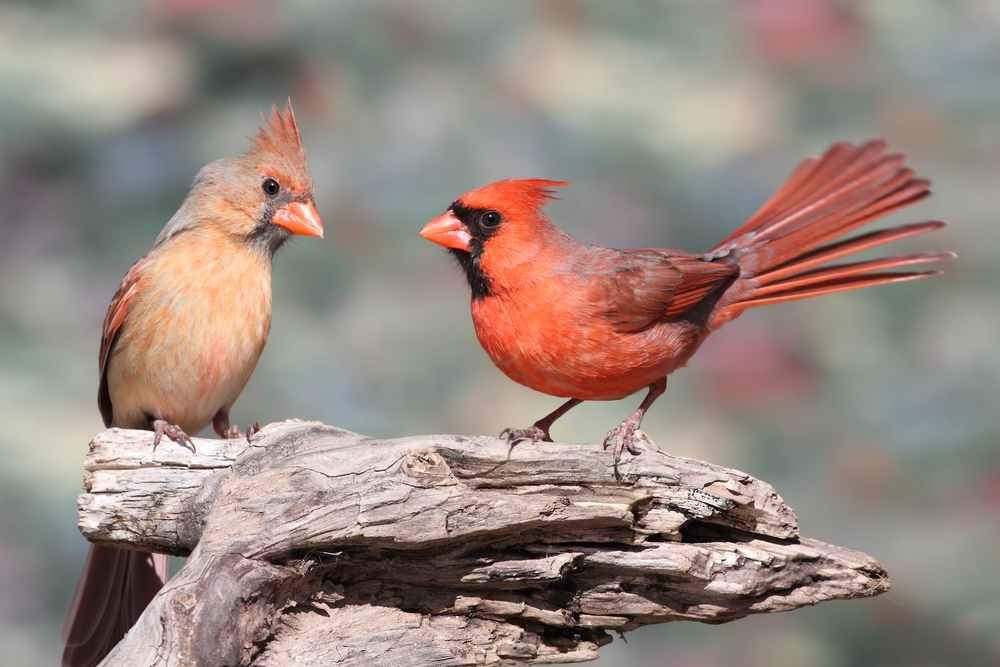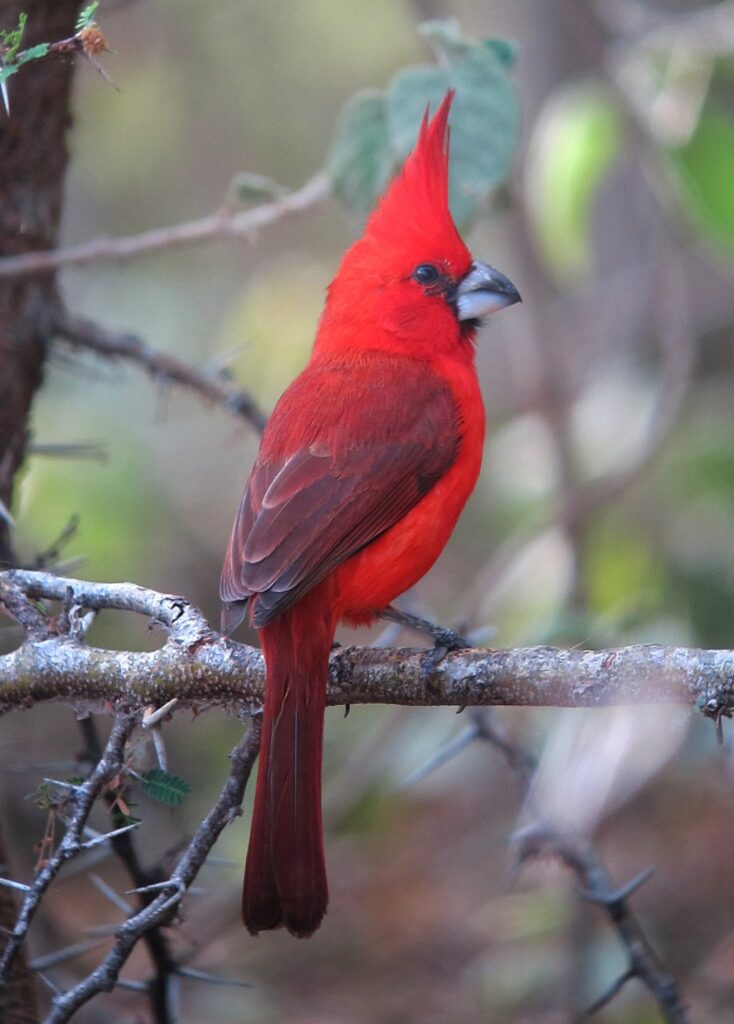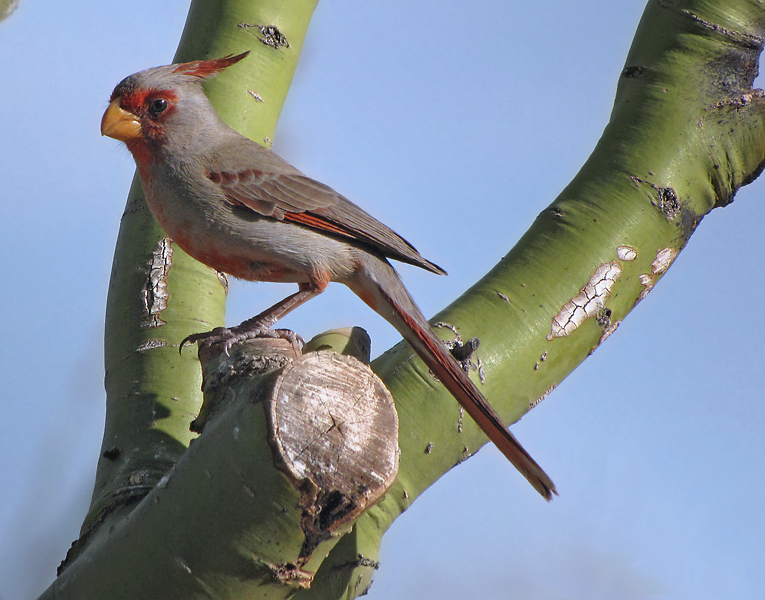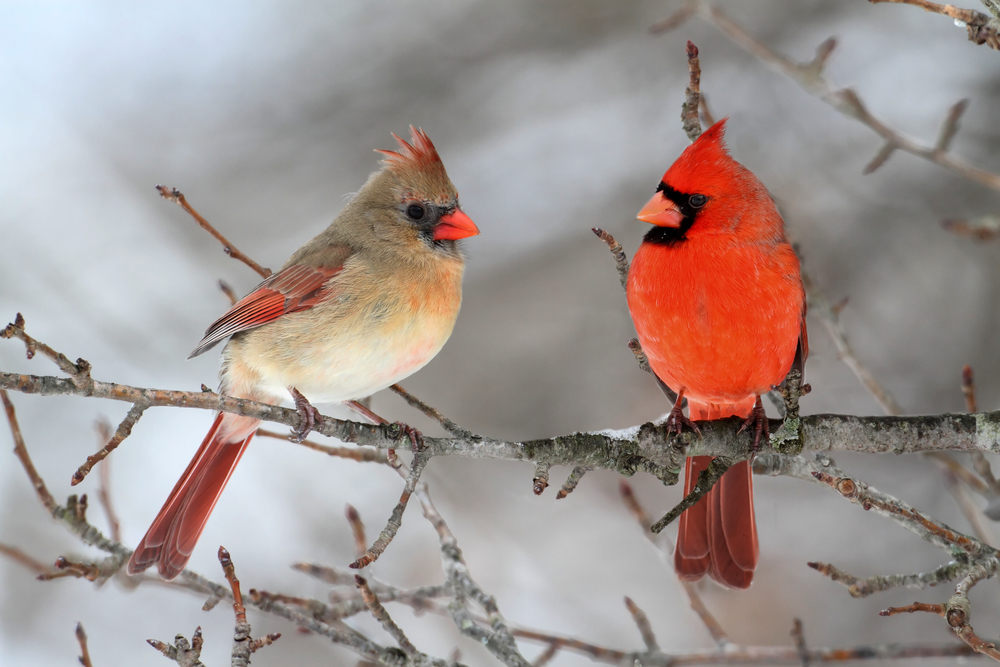Like some birds, most notably mourning doves and swans, Cardinals mate for life. For this reason, you will most often see them hanging out in a pair. These birds are almost impossible to misidentify, thanks to their unique body and beak shape, and downright exotic color. Cardinals are often seen in the winter, and their vibrants hues amid a white or bare landscape are known to bring some festive cheer. For countless years, Cardinals have been filling bird watchers with wonder!
Types of Cardinals in the Unites States
In this article we will be covers the following types of Cardinals along with tips on how to identify them, habitat, calls, diet, interesting behavior, and more!
- Northern Cardinal (Cardinalis cardinalis)
- Vermilion Cardinal (Cardinalis phoeniceus)
- Pyrrhuloxia or Desert Cardinal (Cardinalis sinuatus)
1.The Northern Cardinal

Out of all of the cardinals, this is the most widespread and the most popular. You’ve probably seen it in art, on holiday cards, you name it. That cherry-red bird is the beloved Northern Cardinal.
How to Identify a Northern Cardinal
The Northern Cardinal is almost unmistakable, with its all-over holly-berry color, and its crest, which resembles a mohawk. These vibrant birds look even brighter against the snow in the winter, and they don’t migrate, so you can see them at any time of year! Out of the three types of cardinals, these are the most wide-spread – this means that, if you spot a cardinal, there’s a solid chance that it’s a Northern Cardinal (depending on where you live, of course).
While male Northern Cardinals are the most recognizable, sporting the classic, red color, female Northern Cardinals are also quite lovely. They are mostly a light brown color, with a reddish-auburn tail tips, wing tips, and crests. Male and female cardinals share a patch of color above their noses and on their necks. The female’s patch is light gray, while the male’s patch is a striking, velvety black.
The fledglings are a messy red-brown until they develop their adult light brown or red color. All Northern Cardinals possess the same stocky, medium-sized bodies, and powerful, wedge-shaped, nut-cracking beak.
Rarely, Northern Cardinals may also experience a genetic plumage variation called xanthochroism, causing them to display an unusual vibrant yellow color!
Habitat of the Desert Cardinal
The Northern Cardinal can be found in the Eastern United states, as well as Mexico and Central America. Because they are often ground feeders, Northern Cardinals feel safest when there are shrubs and bushes nearby. These are their preferred nesting locations, as they will give them somewhere to hide, should a predator appear. For this reason, they can be found in overgrown fields, forest edges, hedgerows, wetlands, mesquite, and even amongst ornamental landscaping (if it includes adequate shrubbery or groundcover).
Northern Cardinal Call
Northern Cardinals are known for making chip sounds, or for whistling drawn out melodies (about 2-4 seconds). The females tend to whistle the most cheerfully, while the males will sometimes threaten males with a more aggressive call. One of the most common calls of the Northern Cardinal may sound like ‘cheer, cheer, cheer!’
Where to Spot the Northern Cardinal
Fortunately, it’s hard to miss the breathtaking color of a Northern Cardinal. Northern Cardinals may be seen on the ground, feeding on seeds, or they may perch in trees to sing and let potential mates (or competitors) get a good look!
Interesting Behavior
Male Northern Cardinals can be quite aggressive to fellow male Northern Cardinals during the mating season, which is in the spring-summer.
During this time, they will pick fights over territory more than ever. You may even be rewarded with a rather silly sight: a male Northern Cardinal, fiercely battling his own reflection in a window!
Diet of the Northern Cardinal
Did you know, the berries in their diet are what give Northern Cardinals their exceptional color? Northern Cardinals eat primarily seeds and fruit, including buckwheat, corn, sunflowers, safflower seeds, dogwood fruit, wild grapes, mulberries, hackberries, blackberries, and more.
They also supplement their diet with a variety of insects for protein, and they consider crickets, beetles, katydids, spiders, moths, butterflies, and flies an easy snack.
Black sunflower seeds and safflower seeds are some favorites that will entice Northern Cardinals to your feeder!
Predators of the Northern Cardinal
Northern Cardinals, unfortunately, aren’t so hot at camouflage, with their bright color. This makes them an easy target for domestic cats, which are probably their top predator. They are also preyed on by domestic dogs, as well as foxes, hawks, shrikes, gray squirrels, and owls.
It’s advisable to place feeders only where there are tall shrubs and trees the birds can escape into at the approach of a predator. The feeder should also be out of view of the sky, and the gaze of any passing shirker or hawk.
- Size: 8.2-9.3 inches
- Weight: 1.5 oz
- Wingspan: 10-12 inches
2. The Vermilion Cardinal (Cardinalis phoeniceus)

This desert-dweller is native to Columbia and Venezuela, brightening tropical and subtropical forests and shrublands with its whistling call and exotic color!
How to Identify the Vermilion Cardinal
If you thought the Northern Cardinal was a bright red, take a gander at the Vermilion Cardinal. These gorgeous birds are named for their brilliant, all-over scarlet color. Like the Northern Cardinal, the Vermilion Cardinal has a thick, seed-cracking beak (it is not curved like that of the Desert Cardinal).
Of course, the Vermilion Cardinal has the classic crest of any true Cardinal. This is a bit longer than that of the Northern Cardinal, resembling a magnificent, natural mohawk!
As with all Cardinals, there is a marked difference between the male and female Vermillion Cardinal. While the males are completely red, the females have only red accents, and are gray all over. Otherwise, they share the same shape and beak.
Habitat of the Vermilion Cardinal
The Vermilion Cardinal is a bit less common than the Northern or Desert Cardinals, as they stick mainly to Columbia and Venezuela. This earned them the nickname Venezuelan Cardinal.
Their habitat is tropical or subtropical, and they live in brushlands, forest clearings, you may even see a pair nesting at a park.
Vermilion Cardinal Call
Vermilion Cardinals make a series of metallic ‘chips,’ as well as a whistled call, which is much louder. This is very similar to the call of the Northern Cardinal (and Desert Cardinal).
Where to Spot the Vermilion Cardinal
Your best chance of spotting this somewhat elusive Cardinal is in the early mornings, when males pose and cry out their mating call. They will perch somewhere that female birds (and you, consequently) can get a good view!
Diet of the Vermilion Cardinal
Like the Desert and Northern Cardinals, the Vermilion Cardinal is an avid seed-eater. They are typically ground feeders, helping themselves to buckwheat, wild grasses, sunflower seeds, safflower seeds, etc. They also consume insects, particularly worms and caterpillars, which they consider a protein-filled snack.
Predators of the Vermilion Cardinal
Vermillion Cardinals are not the most adept at camouflage, making them popular prey among domestic cats, domestic dogs, foxes, hawks, shrikes, owls, and even gray squirrels. Thankfully, despite their noticeable appearance, they are good at staying under shrubbery and leaf-cover!
If you want to bring Vermillion Cardinals to your yard, it’s best to provide protection for this ground feeder. Try to place seeds under a tree and/or tarp or umbrella, out of any passing bird of prey’s view!
- Size: 4.7-9.8 inches
- Weight: 0.8-1.5 oz
- Wingspan: 9-11 inches
3. The Pyrrhuloxia or Desert Cardinal (Cardinalis sinuatus)

The Pyrrhuloxia, commonly referred to as the Desert Cardinal, looks quite similar to its Northern cousin (the Northern Cardinal). These beautiful Cardinals have the same medium-sized, stout bodies, striking crests, and thick beaks. There are some key differences between the two, however!
How to Identify a Desert Cardinal
While Northern Cardinals are holly red, Desert Cardinals are a soft, dove gray all over. Their wings, faces, bellies, crests, and tails are accented by a lovely burnt-red color. The last distinguishing characteristic is that, while Northern Cardinals have straight, black, beaks, the Desert Cardinal beaks are yellow and curved, much like a parrot’s beak.
Females look quite similar to the males, except that they are a buffier shade of gray. Their red accents are also a slightly more muted color (sometimes orange rather than red).
Habitat of the Desert Cardinal
While Northern Cardinals prefer a subtropical or tropical habitat, Desert Cardinals live almost solely in the desert, and dry shrub-lands. They can be found in mesquite groves, arid canyons, and dry plains, in South Arizona, New Mexico, and Texas (some have also been seen in Mexico). These desert-dwellers make their nests in dense shrubs trees, such as mesquite or elderberry. You are more likely to see a Desert Cardinal out and about in the winter, since they spend a great deal of time nesting in the spring and summer!
Desert Cardinal Call
Desert Cardinals will mainly make a metallic ‘chip’ or ‘cheep’ sound. This is extremely similar to the call of the Northern Cardinal, except that the sound is noticeably lower and softer (they are also a bit quieter in general; except during mating season, when they get much noisier).
Where to Spot the Desert Cardinal
You may see a Desert Cardinal feeding on the ground in shrubby areas, or perched rather magnificently on a cactus, bush, tree, or phone pole. You might even see one in flight, with a bit of luck.
Interesting Behavior
Sometimes, the territories of the Northern Cardinal and the Desert Cardinal cross. While they are very territorial among their own species, Northern Cardinals and Desert Cardinals do not generally fight with each other!
Diet of the Desert Cardinal
The Desert Cardinal is limited to whatever its desert habitat may offer. Fortunately, they manage to find seeds in wild grasses, fruit in bushes, and they even make use of cacti (for both fruit and ‘water’). In fact, planting these in your garden can be an excellent way to encourage some Desert Cardinals to stop by for a juicy, hydrating snack.
Along with this, Desert Cardinals eat insects, including spiders, weevils, cotton worms, butterflies, moths, katydids, etc. In the summer, when rain becomes scarce, these insects are not just food, but also one of their primary sources of water (along with cacti and fruit).
Predators of the Desert Cardinal
The Desert Cardinal, unfortunately, catches the eye of many predators, from the domestic cat, to the fox, to big desert lizards and snakes, to the shriker or hawk. To survive, the Desert Cardinal has become quite adept at staying under cover. Since Desert Cardinals are ground feeders, it’s highly advisable to provide them with a tarp or umbrella, so they can eat without fear of attack from hawk, raven, or shriker!
- Size: 8.3 inches
- Weight: 0.8-1.5 oz
- Wingspan: 10-12 inches
FAQs about Cardinals
Here are a few common questions and facts about Cardinals!
How to Identify a Cardinal
Luckily for bird watchers, it’s super easy to identify the Cardinal. Males, females, and juveniles alike sport a magnificent mohawk. The males are the most obvious, with their vivid, all over-red color. Females are much more muted in color, with grayer and buffier bodies, and red edging only their wing-tips, crests, and tails (sometimes their faces as well). All cardinals are medium-sized birds, with thick, nut-cracking beaks. Most cardinals have triangular beaks, but the Desert Cardinal is distinguished by a more parrot-like beak.
A Cardinal’s Call
The call of a cardinal varies a bit, from metallic ‘chip’s to ‘cheer, cheer.’ They will also whistle, sometimes in melodies as much as 3-5 seconds long (usually to a mate with the latter!).
What Do Cardinals Eat?
As is apparent by their exceptionally large, thick beaks, Cardinals of all kinds are primarily ground-foragers, and the majority of their diet is made up of seeds, including buckwheat, wild grasses, milo seeds, sunflower seeds, and seeds from the Safflower. They will also supplement their diet with insects, particularly worms, weevils, snails, and caterpillars, but also spiders, flies, butterflies, etc. Finally, they are known to enjoy blueberries and mulberries, blackberries, cherries, and other berries and fruit. They may also sample some sap left behind by a sapsucker, in a fix or as a sweet snack!
Breeding and Nesting Behavior
Cardinals breed in April-September, and you’ll know when a male Cardinal has come to call. These handsome fellows like to perch in conspicuous places in order to sing to their potential mates, where all can get a good view! Once they’re ready to nest, male Cardinals will bring the female the foundations of the nest, which is mostly made up of sticks and bark. She’ll then go about making it comfortable, with things like grass, feathers, and hair.
Cardinals lay eggs in clutches of 2-4, which are white and speckled, and sometimes washed with a pretty blue, green, or brown color. The fathers bring food to the nesting mothers and even look after previous clutches of young, and are impressively loyal.
Cardinal chicks take 11-13 days to hatch, and won’t leave the nest for another 9-12 days. Fledglings don’t lose their drab, reddish-brown baby feathers to take on the recognizable red Cardinal color until they’ve reached full adulthood, at about one year!
How Can You Bring Cardinals to Your Yard?
Cardinals are avid fans of seeds, especially black sunflower seeds and safflower seeds. These birds are typically ground foragers, and are most comfortable eating from the ground or at a ground feeder. If it’s large enough for them to perch on comfortably, they may also use a tree feeder, however!
Predators of the Cardinal (and Ways to Protect Them At Your Feeder)
Cardinals are preyed on widely, thanks to their easy-to-spot red color. They are hunted by domestic cats, domestic dogs, foxes, hawks, shrikes, owls, you name it. If you intend to put out a feeder, make sure that it’s near some bushes or small trees that the Cardinals can flee into. They will also need a leafy canopy, umbrella, or tarp, to shield them from winged predators’ hungry view.
